Trying to disrupt a $14 billion dollar industry is a bold move.
Trying to do disrupt that industry and create the single best product on the market for the best price? Even bolder.
And yet, that’s exactly what Casper’s five founders set out to do in April of 2014. In the words of Liz Welch over at Inc.,
“The concept was simple: Produce the best mattress possible at an affordable price, sell a single model, and deliver it quickly, for free, with a 100-day trial period.”
Not only did the company succeed, but it also thrived. Within its first month, Casper had sales of over $1 million. Now, the company has raised $70 million in venture capital, grown to 120 employees, and hit $100 million in total sales.
Not too shabby, eh?
And we wanted to look under the hood to see how email marketing has played a roll in Casper’s explosive growth. So we subscribed to their email list and monitored their emails.
Here’s what we learned.
Casper’s Welcome Emails
Here’s the first email we received after subscribing.
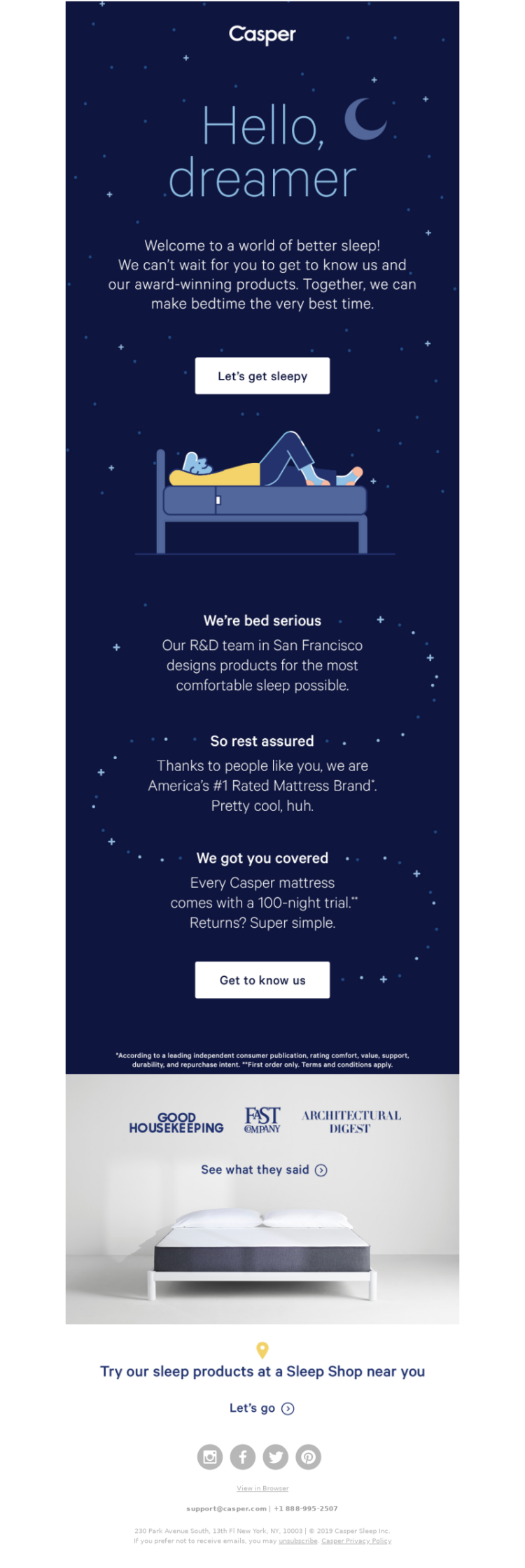
The first thing that we absolutely love about Casper’s email campaigns is the design. Their brand design is relaxed (perfect for what they sell — pillows and mattresses) and confident. In the very first email that a subscriber receives, Casper isn’t afraid to express its unique brand image with cozy colors and silly puns (“We’re bed serious”).
As you can see, this email is wonderfully consistent with Casper’s homepage (as are the rest of their emails).

And that’s an important point. According to Forbes, consistent branding across all channels increases revenue by up to 23%. For good reason, then, 77% of marketing leaders say a strong brand is critical to their growth plans.
If there’s one thing that Casper nailed on launch day, it was their brand image. Since 2014, the company has maintained a healthy, reliable, and high-quality brand image in the eyes of consumers.
They’ve established themselves as the go-to providers for affordable, quality bedding.
And that’s at least partly due to their email campaigns.
Here are a few other things that Casper does well in its welcome email…
- Confidently Establishes Brand Image — Right out of the gate, Casper establishes who its brand is for (people who want to get better sleep), its tone of voice, and its typical color/images/designs. This is important. Don’t confuse the subscriber about what to expect from your emails and marketing materials. Tell them who you are, who you serve, and why you’re awesome right inside your welcome email. It’s also worth mentioning the “Get To Know Us” button which goes to a page dedicated toward telling Casper’s story and building trust with the prospect.
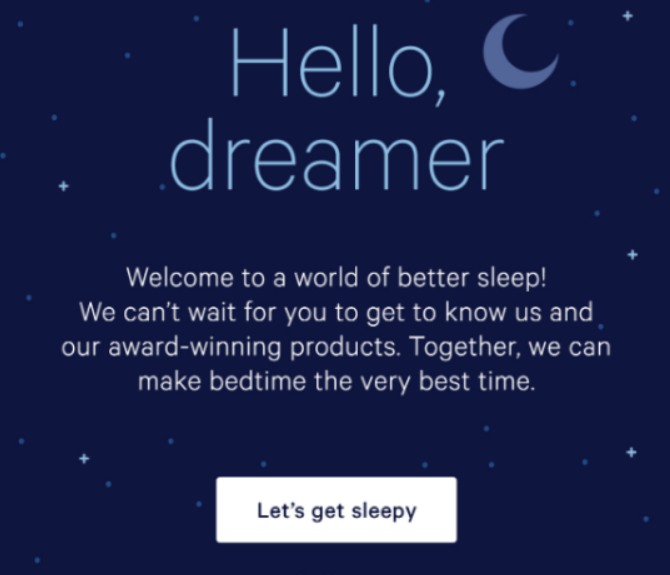
- Social Proof — Remember, the welcome email only goes to people who just signed up for your email list. More than likely, that means they’re new to your business. They might even still be trying to decide whether they trust you or not. So don’t be afraid to add some social proof to your welcome email as Casper does by mentioning big publications that have featured them. Testimonials can have just the same effect.
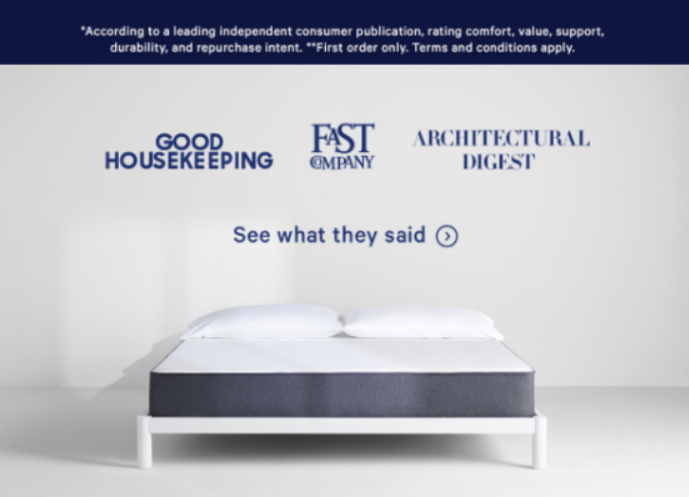
- Risk Reversal — When someone is considering buying something (especially a pillow from an online store), they have concerns. In Casper’s case, perhaps the biggest concern from potential customers is that… well, how do they know the pillow is any good without trying it? That’s why local bedding stores let you lay down and test mattresses and pillows before buying. Casper’s solution is a genius one — a 100-night trial where the buyer can return the item for any reason, no questions asked. But if you’re someone who really wants to try Casper’s products out before purchasing, at the bottom of their welcome email, they encourage the prospect to “Try our sleep products at a sleep shop near you,” removing practically every mental barrier and increasing conversion rate.
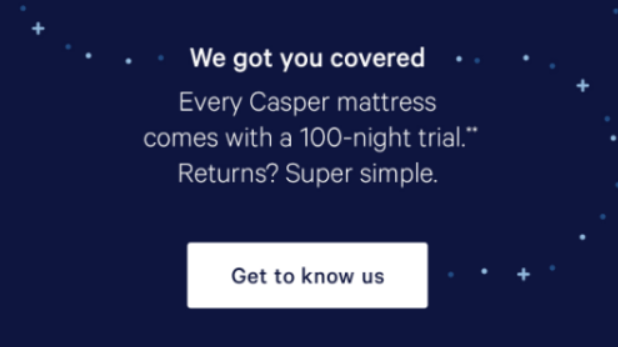
- Social Followers — If someone just signed up for your email list, there’s a good chance that they’re interested in following you on other platforms as well (Facebook, Instagram, Twitter, etc), so why not make the most of this committed moment and invite them to do just that? While Casper’s welcome email is non-invasive with its invite to connect on social platforms, it does include an easy-to-navigate list of the social platforms where the company is active. If people want to follow you, let them.
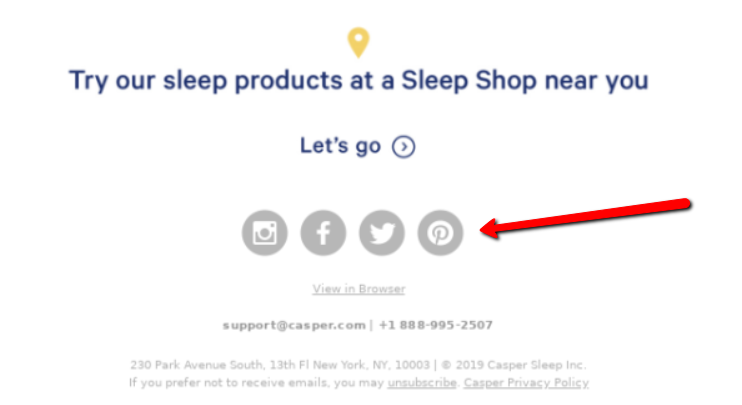
After we received Casper’s welcome email, the company does something even more brilliant. On day 3 of being a subscriber, rather than assume that you’re already convinced to convert, they send an email meant specifically to build trust and rapport. Here’s that email.

We absolutely love this email. Not only is it funny and light-hearted (sticking with Casper’s untainted brand image), but it also allows the subscriber to get a behind-the-scenes peek at how Casper designs, tests, and manufactures its products.
It might be an easy part of Casper’s welcome sequence to overlook, but make no mistake — that transparency is absolutely key to the buyer’s experience. People want to feel like they’re buying from a brand that they really know and understand. In fact, according to research by Label Insight, 94% of customers are likely to show loyalty to a brand that offers complete transparency.
Can you do the same thing with your welcome emails? Can you give a behind-the-scenes peek at how you develop your products, come up with ideas, or even create content? Your customers and prospects crave this kind of content — it allows them to build an authentic relationship with your brand and makes them want to keep coming back for more.
Casper’s Weekly Emails
From our experience, Casper sends between one email and four emails every week. As with most ecommerce businesses, the number of emails they send on any given week seems to vary based on what promotions they have going on at the time.
Casper is fond of week-long promotions, special offers, and flash sales. They also send new product announcements out to their email list.
Let’s take a look at a few noteworthy email promotions the company has done.
First off, “buy a mattress, give a dog bed.”
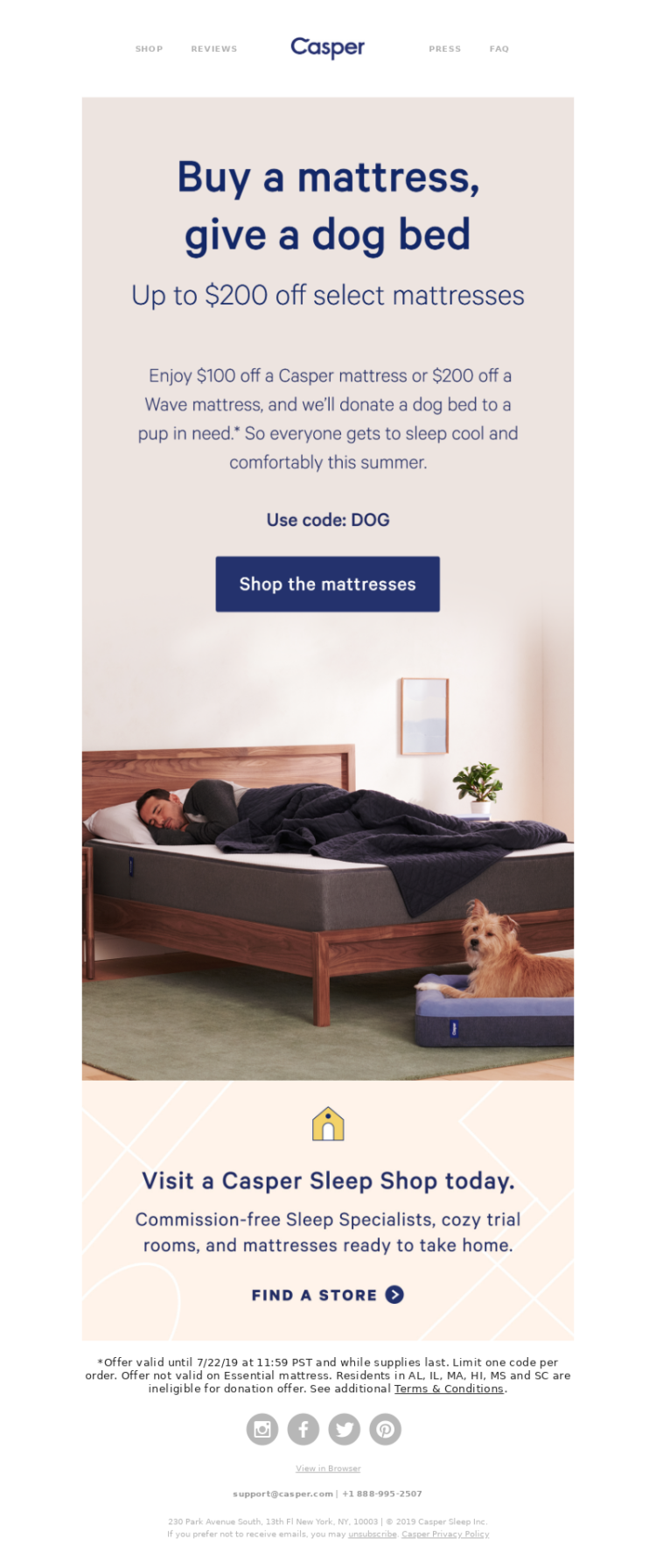
Perhaps copying the famous buy-one-give-one marketing method popularized by companies like Toms and Soapbox, in this promotion, Casper offers to donate a dog bed to a “pup in need” if you buy during the promotional period. They also offer $100 or $200 off your purchase, depending on which product you buy.
That’s a compelling offer — a good sale and the prospect gets to feel like they’re giving back to the world… what’s not to like?
But keep in mind — the buy-one-give-one sales tactic doesn’t always work. One study found, in particular, that…
- “Study participants were more likely to prefer that their purchase triggered the retailer to donate a similar product (53.3%) rather than donate money (33%).”
- “Buy One Give One promotions are more effective at enhancing attitude and purchase intention when bundled with utilitarian products (e.g., toothpaste) compared to hedonistic products (e.g., ice cream).” — which is probably why this tactic can work so well for Casper.
So it depends on the context whether this kind of sales tactic will work for your business. But for Casper, it does.
3 days later, we received this email about the promotion.
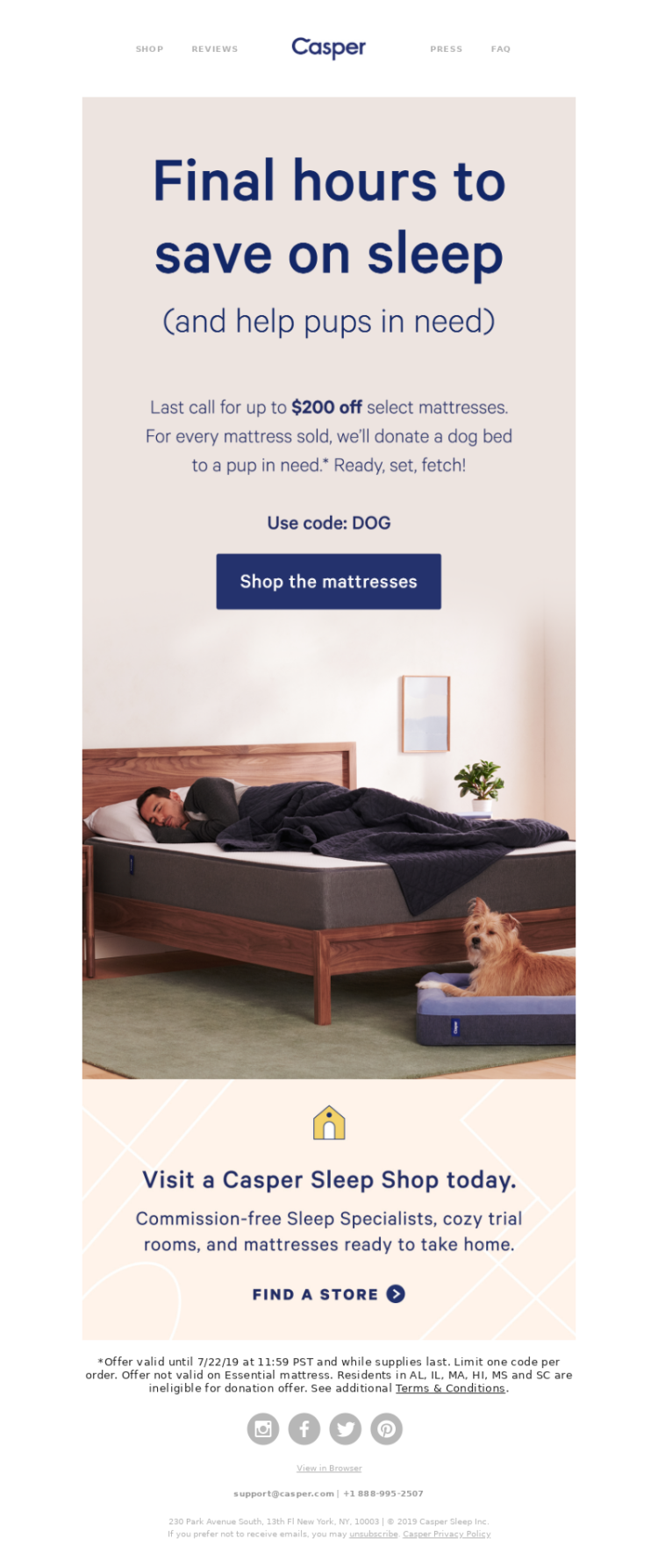
And that’s the last we heard about it. All in all, we received only two emails that week, both of which were in regards to this promotion. In fact, from what we can tell, Casper tries to focus on only one promotion at a time. Many ecommerce stores have flash-sales this and flash-sales that going on all at once in a huge cacophony of confusion. But Casper focuses on just one promotion at a time (typically lasting about a week) and usually only sends 2-4 emails for each promotion.
Here’s another example.
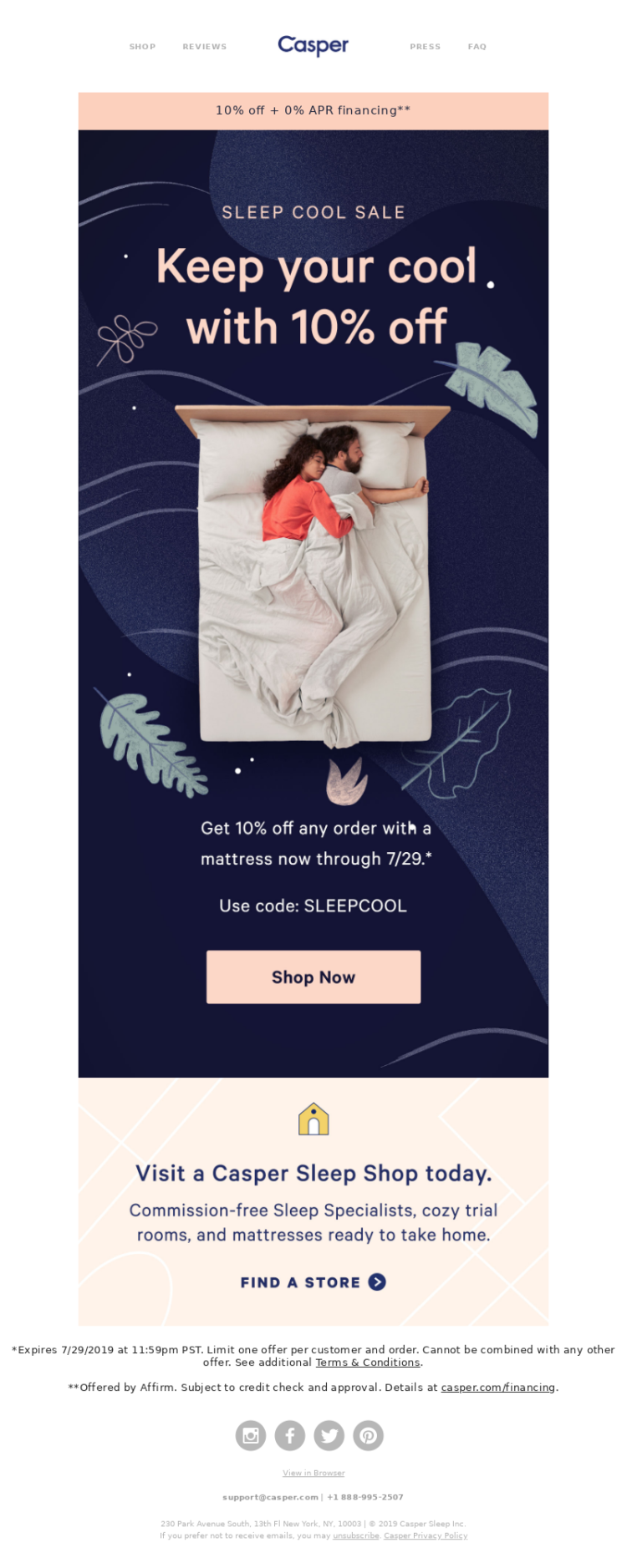
Again, Casper’s branding is on-point within this email and so too is their tone of voice.
What’s interesting about this promotion, though, is that 2 days later (even though I opened the previous email), I received an almost-identical promotional message. The only difference is in the title of the email.
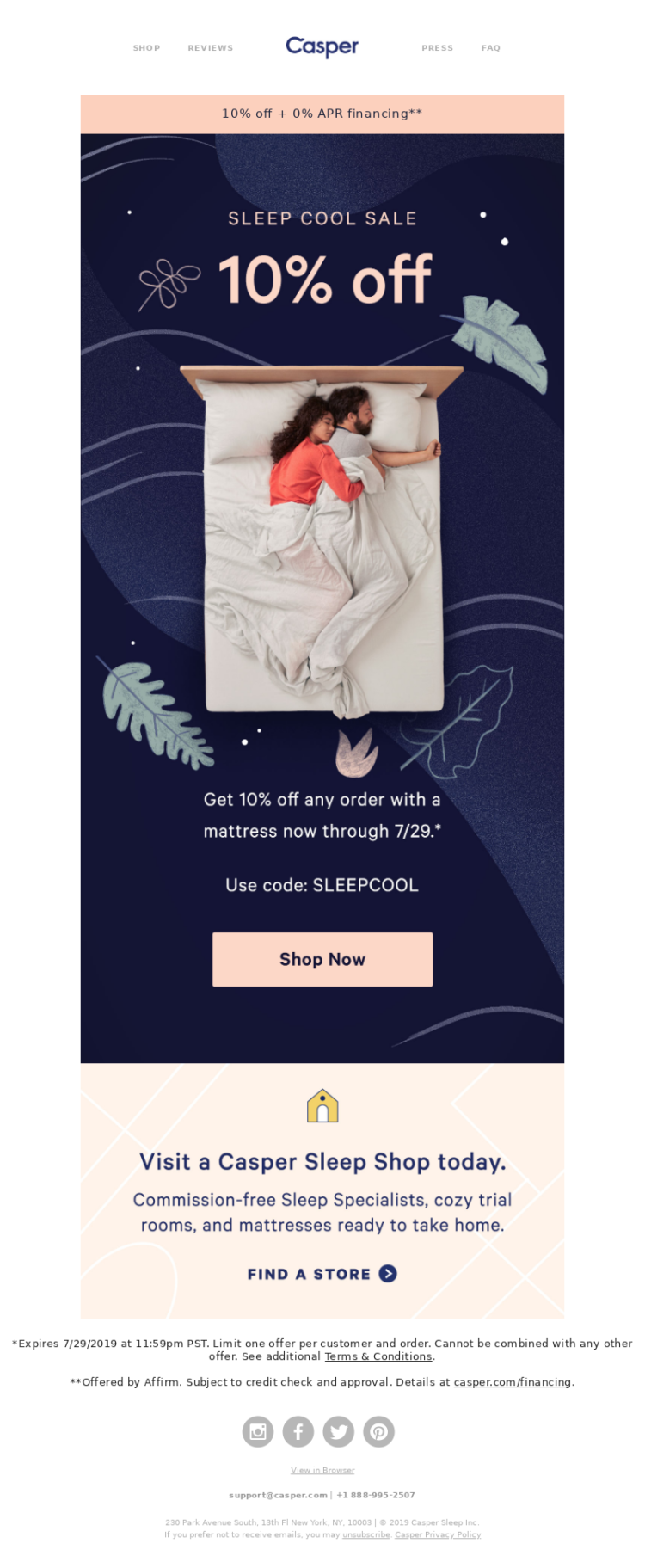
We suppose that could be a time-saving lesson for email marketers. If someone opened but didn’t click on your first promotional email, why not just resend the same email with a different subject line? Just don’t overdo it — most subscribers won’t mind one exact reminder, but more than that will get old fast.
Perhaps the biggest lesson here, though, is to not be afraid to engage with your subscribers in a way that fits with your brand image. Subscribers that love your brand aren’t going to leave because of one small thing they didn’t like (just like a married couple doesn’t get divorced over a single argument). In fact, it’s that humanness that your customers and prospects crave, that transparency.
One day later, we received a final simple reminder for this promotion.

Remember, this promotional stuff doesn’t need to be super sales-y or super complicated. Do like Casper — just tell your subscribers what sale you’re running, when it ends, and send them a few reminders. No biggie. You might be surprised at just how well your promotion does when you don’t add a whole lot of unnecessary fluff.
Note: However, some products do take more explanation and convincing than other products. With what Casper offers (quite a simple product), not much explanation is needed. Once the prospect trusts Casper, good timing and a special offer are probably all that’s needed to push that prospect over the edge. If you sell B2B products or services, though, then this might not apply. There’s certainly something to be said for lengthy and highly persuasive sales pages and emails. The point is, do what works for your business and your products.
Casper’s Abandoned Cart Email
As with all of our email marketing Teardowns, we wanted to see what Casper does with people who abandon their digital shopping cart — what kind of follow-up sequence do they send and when do they send it?
(This is, after all, a vital part of ecommerce)
So we added a Casper mattress to our cart and bounced. The next day, we received this email…

There are a lot of different ways to structure an abandoned cart email. Some ecommerce businesses email out other recommended products, assuming that the prospect lost interest in the previous product. Others offer an additional discount if the prospect finishes their purchase.
But Casper does something a little bit different.
Remember, what’s the biggest barrier to purchase for people who are new to buying bedding material from Casper?
Trust — trust for Casper as a company, yes. But more so, trust for Casper’s products, that they’re comfortable and cozy.
Which is exactly what makes this abandoned cart email so smart. They address that primary concern right at the top: “Still not convinced? Try America’s #1 Rated Mattress.”

And if you follow the asterisk (*), it says “According to a leading independent consumer publication’s rating of the Casper mattress,” which creates transparency that actually reinforces Casper’s claim.
The prospect gets the sense that this is a company that is going to be honest with me.
(and, of course, people like that)
One day later (2 days after abandoning our cart), we received this follow-up email.
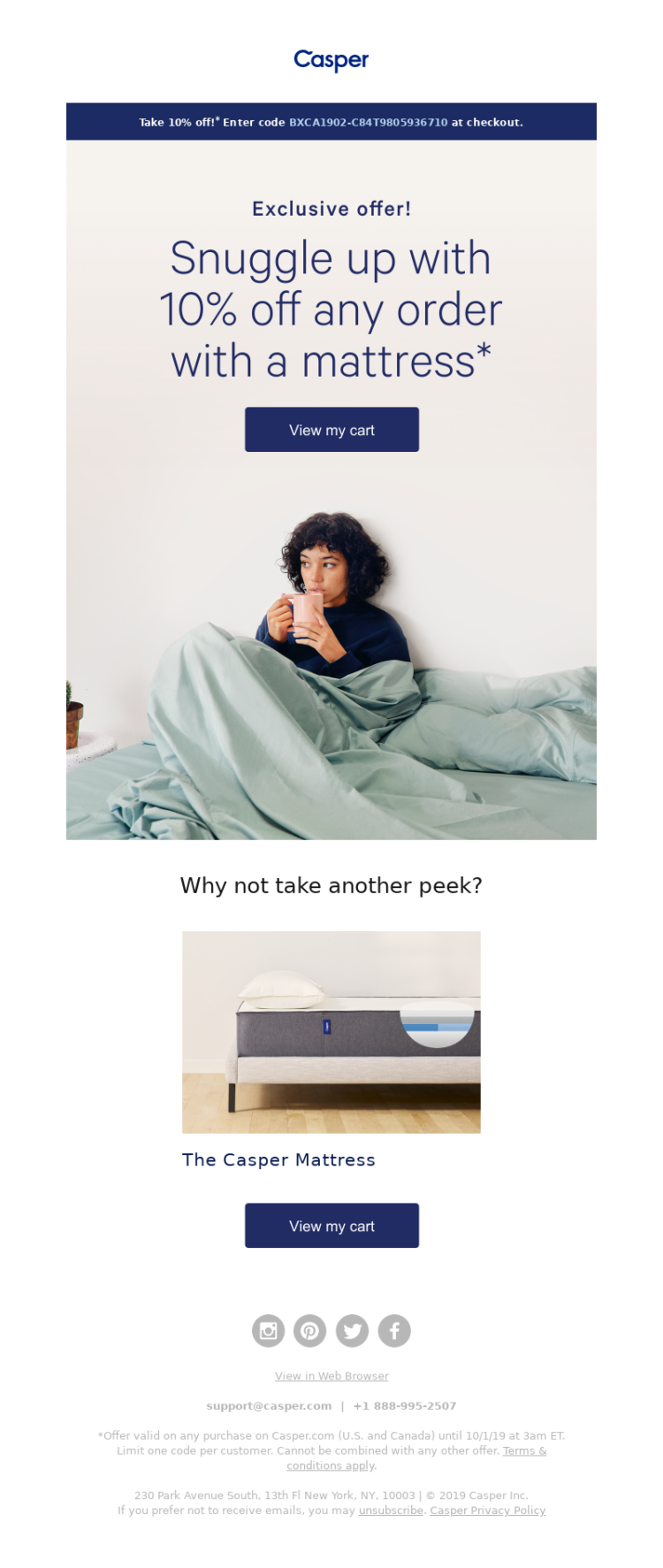
At this point, Casper has done everything they can to reasonably convince the prospect that they’re trustworthy — so to add a little incentive, they send a 10%-off coupon.
If you manage a B2C business’ email marketing efforts, special offers, flash sales, and discounts can be wildly effective. Here are some stats to consider if you’re still not convinced.
- Coupons increase consumer happiness and decrease perceived buying pressure (Source)
- 31 billion digital coupons are expected to be redeemed by the end of 2019 (Source)
- “A recent survey from RetailMeNot found that 80% of shoppers said they feel encouraged to make a first-time purchase with a brand that is new to them if they found an offer or discount. In the absence of a special deal, customers would otherwise abandon their carts.” (Source)
- Two-thirds of consumers said that they have “made a purchase they weren’t originally planning to make solely based on finding a coupon or discount.” (Source)
So why not add a discount email offer to your abandoned cart sequence and see how it does? If it’s good enough for Casper (and many other ecommerce businesses), it’s probably good enough for you. And to find out whether or not a discounted email campaign makes an impact on your conversion rate, you can run a control groups test (learn how to do that over here).
Casper’s Post-Purchase Emails
What happens when you actually buy a product from Casper — what sort of emails does that trigger?
Well, we pulled out our wallets, bought some bedding, and monitored our inbox. Here’s the first email.

This is a great email — simple, on-brand, and to the point. They also include a “Refer friends, earn rewards” offer at the bottom of the email, which is perfect for enticing new customers to introduce their friends to the brand.
Casper is also great at sending delivery notifications during the shipment process (a gesture which most consumers appreciate big-time).
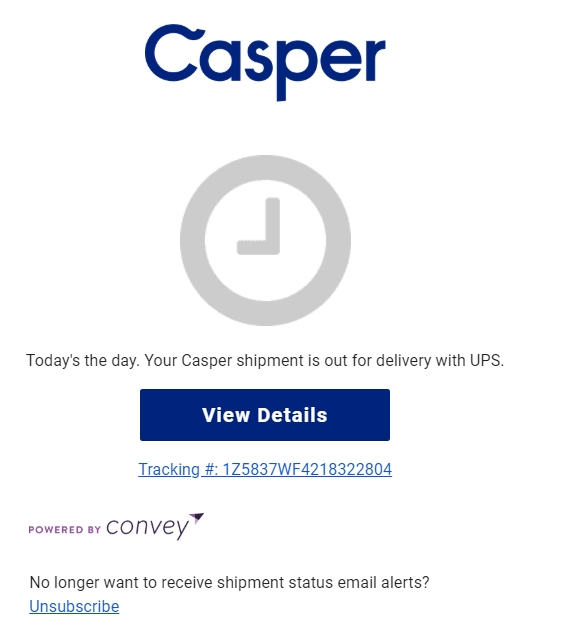
And again…

But Casper doesn’t stop there. Almost 20 days after our purchase (which is smart, because it gives the customer plenty of time to try out the product), Casper sends this email…

This is probably a way for Casper to track the Net Promoter Score (NPS) of their business and to determine how satisfied its customers are. Take note — their one-click system likely gets a high response rate.
And for more detailed feedback, Casper occasionally sends out incentivized surveys (which probably help contribute to product and customer service improvements).
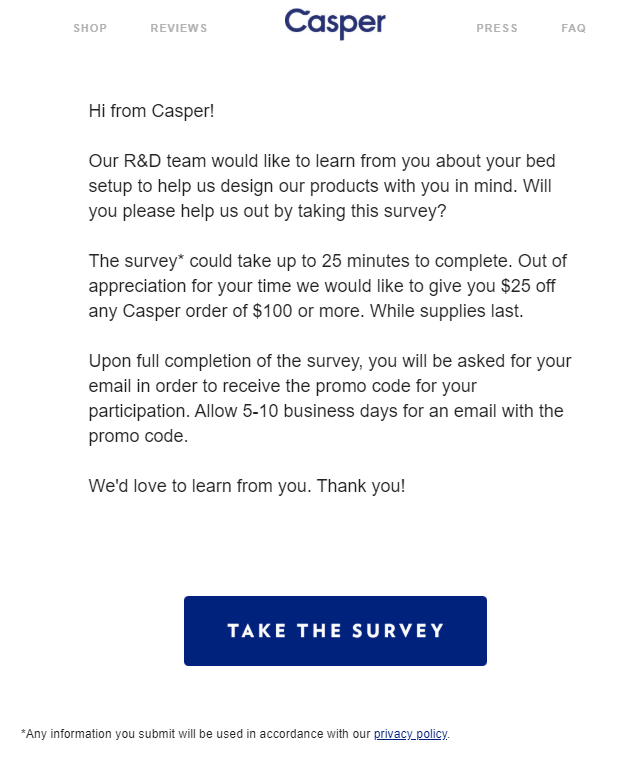
But we received one of our favorite emails almost a month after our original purchase.

That’s an interesting timeline — most email marketers make a point to send out their “please leave a review” email a couple of days or maybe a week after the product has been delivered.
So why does Casper take so long?
Well, to answer that question, we have to understand the kind of products that Casper sells; they sell bedding material — pillows, mattresses, etc. Those are long-term products, things that people use for years into the future. And it’s for that reason (or so we surmise) that they send their “please leave a review” email after an entire month of having purchased. The fact is, people need time to decide what they think of bedding materials, they need to sleep on it for a little while to make up their mind. And so Casper gives its customers the time to do that before encouraging them to leave a review.
Actually, if Casper did the opposite and sent the review email the day of purchase (or even the day after purchase), it’s likely that they’d receive lower-quality reviews and fewer reviews overall (since people wouldn’t have had time to really test out the product). Some companies scramble to collect as many positive, quick-fire reviews as possible, but Casper trusts its superior quality bedding to impress and delight its customers over the long-term, and so they are not afraid to give people time to really test out those products.
The lesson here is to consider what kind of product you’re selling. If you’re selling a one-time-use product (like bath bombs), then sending a review request a week after delivery probably makes sense. But if you’re selling a long-term product that people will use every day for years to come, then waiting a month to ask for a review could benefit your business (so long as your product is actually high-quality).
Download the visualized teardown
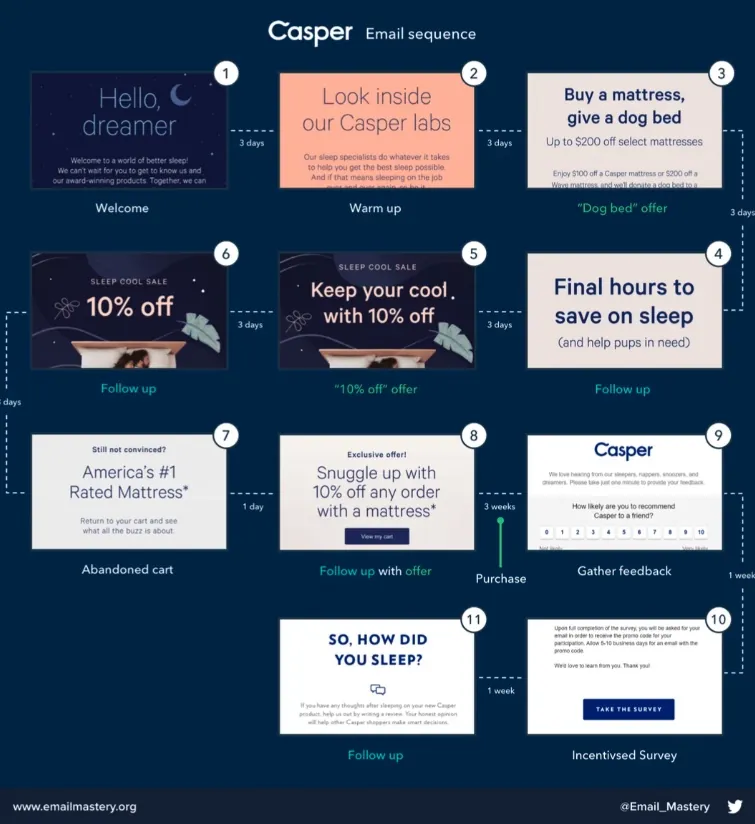
Download the Visualised Teardown
Enter your email address to download our one-page visualisation.
We respect your privacy. Unsubscribe at any time.
Conclusion
There’s no denying it: Casper is a remarkable company. It’s managed to massively disrupt a $14 billion industry, it’s created a trust-worthy brand image, and it’s maintained that brand image through consistent email quality and even higher quality products.
And now you’ve got a peek behind the scenes of how Casper uses email marketing to grow its business.
The only question left is: how can you implement what you’ve learned to improve your email marketing and build the business of your entrepreneurial dreams?
discuss on twitter